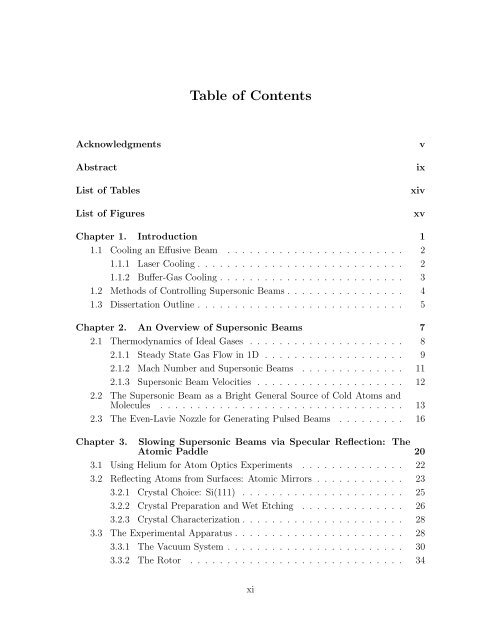Experiments with Supersonic Beams as a Source of Cold Atoms
Experiments with Supersonic Beams as a Source of Cold Atoms
Experiments with Supersonic Beams as a Source of Cold Atoms
Create successful ePaper yourself
Turn your PDF publications into a flip-book with our unique Google optimized e-Paper software.
Table <strong>of</strong> Contents<br />
Acknowledgments v<br />
Abstract ix<br />
List <strong>of</strong> Tables xiv<br />
List <strong>of</strong> Figures xv<br />
Chapter 1. Introduction 1<br />
1.1 Cooling an Effusive Beam . . . . . . . . . . . . . . . . . . . . . . . . 2<br />
1.1.1 L<strong>as</strong>er Cooling . . . . . . . . . . . . . . . . . . . . . . . . . . . . 2<br />
1.1.2 Buffer-G<strong>as</strong> Cooling . . . . . . . . . . . . . . . . . . . . . . . . . 3<br />
1.2 Methods <strong>of</strong> Controlling <strong>Supersonic</strong> <strong>Beams</strong> . . . . . . . . . . . . . . . . 4<br />
1.3 Dissertation Outline . . . . . . . . . . . . . . . . . . . . . . . . . . . . 5<br />
Chapter 2. An Overview <strong>of</strong> <strong>Supersonic</strong> <strong>Beams</strong> 7<br />
2.1 Thermodynamics <strong>of</strong> Ideal G<strong>as</strong>es . . . . . . . . . . . . . . . . . . . . . 8<br />
2.1.1 Steady State G<strong>as</strong> Flow in 1D . . . . . . . . . . . . . . . . . . . 9<br />
2.1.2 Mach Number and <strong>Supersonic</strong> <strong>Beams</strong> . . . . . . . . . . . . . . 11<br />
2.1.3 <strong>Supersonic</strong> Beam Velocities . . . . . . . . . . . . . . . . . . . . 12<br />
2.2 The <strong>Supersonic</strong> Beam <strong>as</strong> a Bright General <strong>Source</strong> <strong>of</strong> <strong>Cold</strong> <strong>Atoms</strong> and<br />
Molecules . . . . . . . . . . . . . . . . . . . . . . . . . . . . . . . . . 13<br />
2.3 The Even-Lavie Nozzle for Generating Pulsed <strong>Beams</strong> . . . . . . . . . 16<br />
Chapter 3. Slowing <strong>Supersonic</strong> <strong>Beams</strong> via Specular Reflection: The<br />
Atomic Paddle 20<br />
3.1 Using Helium for Atom Optics <strong>Experiments</strong> . . . . . . . . . . . . . . 22<br />
3.2 Reflecting <strong>Atoms</strong> from Surfaces: Atomic Mirrors . . . . . . . . . . . . 23<br />
3.2.1 Crystal Choice: Si(111) . . . . . . . . . . . . . . . . . . . . . . 25<br />
3.2.2 Crystal Preparation and Wet Etching . . . . . . . . . . . . . . 26<br />
3.2.3 Crystal Characterization . . . . . . . . . . . . . . . . . . . . . . 28<br />
3.3 The Experimental Apparatus . . . . . . . . . . . . . . . . . . . . . . . 28<br />
3.3.1 The Vacuum System . . . . . . . . . . . . . . . . . . . . . . . . 30<br />
3.3.2 The Rotor . . . . . . . . . . . . . . . . . . . . . . . . . . . . . 34<br />
xi
















